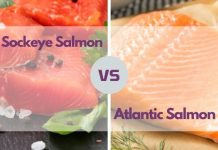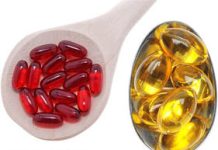Sockeye Salmon vs Atlantic Salmon: The Differences in Taste, Nutrition, and Habitat
The differences between two popular species: sockeye salmon and Atlantic salmon. Discover the unique characteristics, flavors, and habitats that set these mighty fish apart.
Salmon holds significant importance in culinary traditions and the fishing industry. Their flavorful flesh, rich in omega-3 fatty acids, has made them a sought-after delicacy worldwide. Understanding the distinctions between sockeye salmon and Atlantic salmon can help seafood enthusiasts make informed choices when selecting their preferred salmon species.

By exploring the appearance, taste, nutrition, habitat, and sustainability of both sockeye and Atlantic salmon, this article aims to provide a comprehensive comparison that can assist readers in understanding the unique qualities of each species.
Appearance
Sockeye salmon, also known as red salmon, showcases a vibrant, deep red color that sets it apart from other salmon species. They typically measure between 24 to 33 inches in length and weigh around 5 to 15 pounds. Sockeye salmon possess a streamlined body with a slightly forked tail and small scales. During the spawning season, the males develop a humped back and a hooked jaw, which adds to their distinctive appearance.
On the other hand, Atlantic salmon, also known as Salmo salar, exhibits a silvery-blue color with a greenish tinge on its back. They are generally larger than sockeye salmon, measuring between 28 to 30 inches in length and weighing around 8 to 12 pounds. Atlantic salmon have a more elongated body shape and larger scales compared to sockeye salmon.
While both species possess unique physical attributes, sockeye salmon’s striking red color and distinct facial features make it instantly recognizable, while Atlantic salmon’s silvery hue gives it an elegant appearance.
Taste and Texture
Sockeye salmon is renowned for its rich, robust flavor. Its flesh is succulent, with a pronounced taste that is often described as nutty and slightly sweet. The texture of sockeye salmon is firm and meaty, with a moderate oil content that contributes to its luscious mouthfeel.
Atlantic salmon, on the other hand, offers a milder flavor compared to sockeye salmon. Its taste is delicate and buttery, with a hint of sweetness. The texture of Atlantic salmon is also softer and more tender, making it an excellent choice for those who prefer a more delicate eating experience.
When comparing the taste and texture of both species, sockeye salmon’s bolder flavor and firmer texture make it a favorite among those who enjoy a more intense salmon experience. However, individuals who prefer a milder, melt-in-your-mouth sensation may lean towards the delicate taste and tender texture of Atlantic salmon.
Nutritional Value
Sockeye salmon is not only a delicious choice but also a highly nutritious one. It is packed with essential nutrients, making it a valuable addition to a healthy diet. Sockeye salmon is an excellent source of omega-3 fatty acids, which are known for their heart-healthy benefits. These fatty acids help reduce inflammation, improve brain function, and support overall cardiovascular health.
In addition to omega-3s, sockeye salmon is rich in high-quality protein, providing all the essential amino acids needed by the body. It is also a good source of vitamins such as vitamin D, vitamin B12, and vitamin B6, as well as minerals like selenium and potassium.
Atlantic salmon shares many nutritional similarities with sockeye salmon. It is also a great source of omega-3 fatty acids, protein, and essential vitamins and minerals. While the exact nutrient composition may vary slightly, both species offer significant health benefits.
When comparing the nutritional profiles of sockeye salmon and Atlantic salmon, both species are highly nutritious and provide essential nutrients needed for optimal health. The omega-3 content, protein quality, and vitamin and mineral composition are comparable, making them both excellent choices for individuals looking to enhance their diet with nutrient-rich seafood.
Habitat and Lifecycle
Sockeye salmon are native to the Pacific Ocean and are found in cold, freshwater environments such as rivers and lakes. They have a unique lifecycle that involves spawning in freshwater, migrating to the ocean to grow and mature, and returning to their birthplace to reproduce. This incredible journey can span hundreds of miles, and sockeye salmon are known for their remarkable ability to navigate back to their natal streams with remarkable precision.
Atlantic salmon, on the other hand, are native to the northern Atlantic Ocean. They prefer colder waters and are commonly found in rivers and estuaries along the coastlines of North America and Europe. Similar to sockeye salmon, Atlantic salmon also exhibit anadromous behavior, migrating from freshwater rivers to the ocean and back to spawn.
While both species share a similar lifecycle and exhibit anadromous behavior, their habitats differ. Sockeye salmon primarily inhabit the Pacific Ocean and its surrounding freshwater systems, while Atlantic salmon are found in the Atlantic Ocean and its adjacent rivers and estuaries.
Understanding the habitat preferences and lifecycle of sockeye salmon and Atlantic salmon is crucial for conservation efforts and ensuring the preservation of their populations. It also provides insight into the unique adaptations and behaviors that allow these remarkable fish to thrive in their respective environments.
Environmental Impact and Sustainability
Examining the environmental impact of salmon fishing is essential for promoting sustainable practices and preserving these valuable species. Sockeye salmon fishing, when conducted responsibly, can have positive effects on ecosystems and local economies. Harvesting sockeye salmon supports the livelihoods of many fishing communities, providing economic opportunities and contributing to the food supply.
However, overfishing and habitat degradation can pose significant challenges to the sustainability of sockeye salmon populations. It is crucial to manage fishing quotas and implement conservation measures to ensure the long-term viability of these fish. Efforts such as habitat restoration, monitoring of spawning grounds, and implementing sustainable fishing practices are essential for maintaining healthy sockeye salmon populations.
Atlantic salmon fishing also has environmental implications, both positive and negative. While wild Atlantic salmon populations have declined in many regions due to overfishing and habitat loss, the rise of salmon aquaculture has provided an alternative source of Atlantic salmon. However, the environmental impact of salmon farming, such as pollution and the escape of farmed fish into the wild, can have negative consequences on wild salmon populations and the surrounding ecosystem.
The sustainability of Atlantic salmon populations relies on responsible aquaculture practices, including proper waste management, reducing the use of antibiotics, and preventing escapes into the wild. Additionally, habitat conservation efforts and the restoration of spawning grounds are crucial for supporting wild Atlantic salmon populations.
When comparing the environmental impact and sustainability of sockeye salmon and Atlantic salmon, it is important to consider factors such as fishing methods, population management, and ecological implications. Both species require careful management and conservation efforts to ensure their survival and minimize the impact on their habitats.
By supporting sustainable fishing practices, choosing certified sources, and advocating for responsible aquaculture, individuals can contribute to the preservation of sockeye salmon and Atlantic salmon populations while enjoying the culinary delights they offer.
FAQs
Here are some frequently asked questions about the differences between sockeye salmon and Atlantic salmon:
How do sockeye salmon and Atlantic salmon differ in taste?
Sockeye salmon has a rich, robust flavor with a slightly sweet and nutty taste. Atlantic salmon, on the other hand, offers a milder and buttery flavor. The difference in taste is primarily due to variations in their diet and habitat.
Are sockeye salmon and Atlantic salmon equally nutritious?
Both sockeye salmon and Atlantic salmon are highly nutritious. They are excellent sources of omega-3 fatty acids, protein, and essential vitamins and minerals. While there may be slight variations in their nutrient composition, both species provide significant health benefits.
Can sockeye and Atlantic salmon be found in the same habitats?
No, sockeye salmon and Atlantic salmon prefer different habitats. Sockeye salmon are native to the Pacific Ocean and its surrounding freshwater systems, while Atlantic salmon are found in the northern Atlantic Ocean and its adjacent rivers and estuaries.
Which salmon species is more sustainable for consumption?
Both sockeye salmon and Atlantic salmon can be consumed sustainably. It is important to choose salmon from well-managed fisheries or certified sustainable sources to minimize environmental impact and support the long-term viability of salmon populations.
What are the primary factors contributing to the decline in sockeye salmon populations?
Several factors contribute to the decline in sockeye salmon populations, including overfishing, habitat degradation, and climate change. These factors can disrupt their spawning grounds, affect their migration patterns, and impact their overall survival.
Are there any significant health risks associated with consuming sockeye or Atlantic salmon?
When consumed in moderation, both sockeye salmon and Atlantic salmon are safe and offer numerous health benefits. However, individuals with specific allergies or medical conditions should consult with a healthcare professional before incorporating salmon into their diet.
Can sockeye and Atlantic salmon be cooked using the same recipes?
Yes, sockeye salmon and Atlantic salmon can be cooked using the same recipes. Their similar texture and flavor profiles make them interchangeable in various dishes such as grilled, baked, or pan-seared preparations.
How do sockeye and Atlantic salmon compare in terms of price and availability?
Sockeye salmon is often more readily available and less expensive compared to Atlantic salmon. Availability and pricing can vary based on factors such as location, season, and demand.
Are there any cultural or regional differences in the preference for sockeye or Atlantic salmon?
Preferences for sockeye salmon or Atlantic salmon can vary based on cultural and regional traditions. For example, sockeye salmon is highly esteemed in Pacific Northwest cuisine, while Atlantic salmon is popular in European and North American culinary traditions.
What are some alternative salmon species that can be considered substitutes for sockeye and Atlantic salmon?
Some alternative salmon species that can be considered substitutes for sockeye and Atlantic salmon include coho salmon, pink salmon, and Chinook salmon. These species offer their unique flavors and characteristics.
Conclusion
Whether you prefer the vibrant red hues and bold flavors of sockeye salmon or the delicate taste and versatility of Atlantic salmon, both species offer unique culinary experiences deeply intertwined with our ecosystems and traditions. Understanding the distinctions between sockeye salmon and Atlantic salmon in appearance, taste, nutrition, habitat, and sustainability allows us to make informed choices that align with our preferences and values. Salmon, in all its diverse forms, continues to captivate our palates and nourish our bodies. By appreciating the remarkable qualities of these magnificent fish, we can celebrate the wonders of nature and contribute to the conservation of these valuable species for future generations to enjoy.




